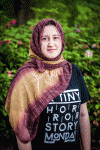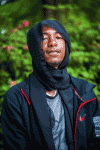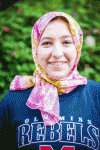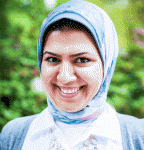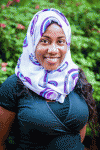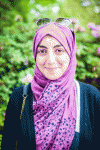The Muslim Student Association let students walk in another’s shoes- or rather, headscarves, Tuesday.
UM MSA members helped students try on hijabs in front of the Union from 11 a.m. to 1 p.m. for those who wanted to experience wearing the cover on campus.
Passersby stopped between classes, still clutching bags of Chick-fil-A and hauling textbooks, to wear a Muslim head covering for the first time. Students also offered Henna paintings, Arabic writing demonstrations and photobooth-style pictures.
Event organizers helped fasten scarves from their own collections onto interested participants and encouraged conversation about the cultural experience of wearing a hijab on campus.
“There’s a lot of pretty awful stigmas and stereotypes against Muslims and especially Muslim women because they wear head coverings, so I’m happy to see events like these because maybe that’ll help break some of those,” participant and sophomore linguistics major Amy Buchheit said.
Hijab is an Arabic word meaning a cover, barrier or partition. For many Muslim women, though, the hijab is one of a variety of coverings worn for cultural reasons or as a religious commitment to modesty.
Buchheit said she had never worn any kind of veil or headscarf before, but several of her friends were helping run the event and she was curious about trying on a hijab.
“Even though I’m from a small town in Iowa, there are also quite a few Muslim women there, so I have wondered before what that’s like,” Buchheit said. “I’m not religious whatsoever, so just to have that dedication to not only wearing it, but sending that message to other people, I think that’s pretty cool. That’s pretty solid faith.”
Hunain Alkhateb, UM MSA faculty advisor, said wearing a hijab sets boundaries for her.
“When I deal with my students and my colleagues, they’ll say ‘Okay, can I hug you?'” Alkhateb said. “They would ask, but typically with other people, if they got excited, they would probably just jump and hug you. I like setting these boundaries, it helps me keep my religious practices and culture.”
When graduate student Tassniem Rashed came to the University, her parents suggested she cover less to assimilate into American culture in the South. Rashed, though, still wears a niqab, a veil covering a woman’s entire face and hair, except for her eyes.
“The way that I cover pretty much almost everything, it’s the way that I feel empowered that I would decide who would get to see my physical appearance,” Rashed said. “I would like people to judge me for my intellect and the way I interact with them, not the way that I look, although I really like the way that I look. I want people to look through or beyond the beauty or the physical appearance.”
Adham Hagag, president of UM MSA, said the cooperation with OpenMISS helped draw larger crowds than the previous three years of the event’s history.
OpenMISS, a student-led project to highlight local Muslim communities, began working with MSA in February.
“We are targeting the same audience over here, so it makes it much easier that we can always work on the same tasks together,” Hagag said.
On Monday, OpenMISS students held a dialogue on cultural diversity in front of the Union. So, when project member Alexandra Gersdorf donned a hijab the next day, she said she felt she was putting words into action.
“This is cultural diversity, so I think it’s important to participate in it and not just talk about it,” Gersdorf said.








